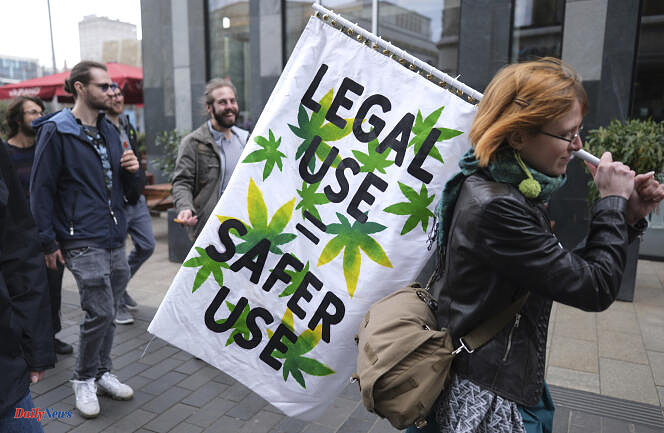After Malta and Luxembourg, on April 1, Germany became the third country in the European Union to legalize the “recreational” use of cannabis. Possession of 25 grams of dried cannabis is now permitted in public places, as is cultivation at home. Distribution will be done, from July 1 only, by “cannabis clubs”, associations responsible for cultivation and sales to members.
As in all countries where the legalization of cannabis is discussed, its opponents fear an increase in consumption, particularly among young people under 25 for whom this drug presents an increased risk to the brain.
Only twelve countries have partially or fully legalized cannabis worldwide, but only a handful have done so long enough to allow analysis of its effects on consumption. This is the case of Uruguay, which took the plunge in 2013, but also of a few American states, such as Colorado and Washington State (2014) and finally of Canada, in 2018. Each of these states has adopted a different approach but the finding is the same: the surveys all show an increase in cannabis consumption among adults. As for minors, no increase (apart from Uruguay), but it is difficult to attribute this result to legalization since this trend is global.
Possible reporting biases in surveys
This increase in consumption among adults can first be explained by the difficulty of measuring drug use in society. In all prevalence surveys, underreporting is a well-known methodological problem. Due to the legal prohibition and even if the anonymity of respondents is guaranteed, the consumers interviewed may fear recognizing a stigmatized practice. By becoming legal, the consumption of cannabis can be more easily accepted, which can be reflected in the surveys.
“We cannot measure consumption with constant bias, we can therefore imagine that part of the increase observed in countries that have legalized cannabis is due to the freedom of speech due to the fact that it is no longer illicit behavior », suggests Ivana Obradovic, deputy director of the French Observatory of Drugs and Addictive Tendencies (OFDT). It is impossible, however, to know how much of the increase could be due to these reporting biases.
Greater availability and diversification of the offer
In any case, the results of an OFDT survey on the effects of legalization in North America, published at the end of 2023, are clear: “Legalization appears to contribute to a wider distribution of the product among the adults. »
In American states, rather business-friendly regulatory models, with the aim of increasing tax revenues, have led to an increase in the number of products and ways of consuming: cannabis is consumed more often and in greater quantities. Dried cannabis remains at the top of sales, but the appearance of new edible products (sodas, gummies, cakes) and concentrates has attracted new audiences.
The opening of numerous shops has also increased the visibility of this drug in public spaces. At the start of 2021, there were 14 stores per 100,000 residents in Colorado. Seven years after the market opened, 3,000 brands were listed in this state and in Washington State, each marketing on average 40 to 60 cannabis products, according to data analyzed by Ivana Obradovic.
“One of the effects of legalization is that more seniors have started to consume cannabis, moving towards products concentrated in CBD, praised for their relaxing or pain-relieving effects,” explains the researcher, also author of the book Le Cannabis published by La Découverte (“Repères” collection, 2022). Unlike THC (delta-9-tetrahydrocannabinol), more sought after by younger age groups, CBD (cannabidiol) does not have psychotropic effects.
A drop in prices and a black market difficult to dry up
One of the arguments put forward by defenders of legalization is always to combat the illicit market. Legal production must then align with street prices. Competition is established between the two markets, legal and illegal, which leads to an overall drop in cannabis prices. “If the general drop in prices on legal cannabis markets can help reduce the illicit market, it can also lead to an increase in consumption,” notes the OFDT study.
Always gradual, the decline of the black market can be more or less rapid depending on the States and the regulatory models put in place. In Uruguay, where legalization was passed in 2013, the implementation of restrictive regulation has been slow and legal supply in pharmacies or in “cannabis social clubs” remains complicated. The limited production capacity of the legal market and the resulting shortage may have diverted consumers towards the black market. So much so that in 2018 only one in three cannabis users said they obtained it through legal channels, according to a report from the Uruguayan Drug Observatory.
In certain American states, on the contrary, it is overproduction which constitutes one of the main counterproductive effects of legalization. Legal production sometimes greatly exceeds demand, as in Oregon where supply covered seven years of local demand as of 2019, according to the OFDT study. Due to the federal and international ban, this overproduction cannot be exported or transported to another state and often ends up being diverted to the black market, once again contributing to the drop in prices.
The fact remains that legalization still has the advantage of bringing users back to a previously non-existent legal market, with controlled products, known health risks and targeted prevention campaigns. Health Canada data in this sense is more reassuring: it shows that in 2023, five years after the opening of a legal market, three-quarters (73%) of people who declared having consumed cannabis during year had purchased their cannabis from a legal source.
For Ivana Obradovic, “the question is what is the priority objective knowing that there are always several: health? Security ? Economic profitability? ". Countries adopting these new laws must then find the equation that allows them to generate tax revenue without worsening public health problems. “No state that has legalized cannabis has yet found the optimal formula,” points out the deputy director of the OFDT. The search for the balance point is still ongoing. »












